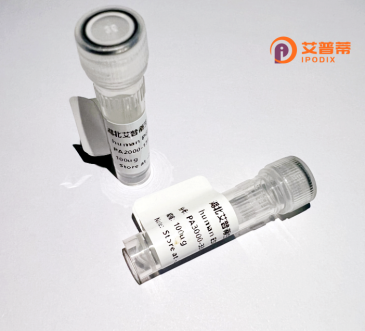
| 纯度 | >90%SDS-PAGE. |
| 种属 | Human |
| 靶点 | MTMR10 |
| Uniprot No | Q9NXD2 |
| 内毒素 | < 0.01EU/μg |
| 表达宿主 | E.coli |
| 表达区间 | 1-777 aa |
| 活性数据 | MFSLKPPKPT FRSYLLPPPQ TDDKINSEPK IKKLEPVLLP GEIVVNEVNF VRKCIATDTS QYDLWGKLIC SNFKISFITD DPMPLQKFHY RNLLLGEHDV PLTCIEQIVT VNDHKRKQKV LGPNQKLKFN PTELIIYCKD FRIVRFRFDE SGPESAKKVC LAIAHYSQPT DLQLLFAFEY VGKKYHNSAN KINGIPSGDG GGGGGGGNGA GGGSSQKTPL FETYSDWDRE IKRTGASGWR VCSINEGYMI STCLPEYIVV PSSLADQDLK IFSHSFVGRR MPLWCWSHSN GSALVRMALI KDVLQQRKID QRICNAITKS HPQRSDVYKS DLDKTLPNIQ EVQAAFVKLK QLCVNEPFEE TEEKWLSSLE NTRWLEYVRA FLKHSAELVY MLESKHLSVV LQEEEGRDLS CCVASLVQVM LDPYFRTITG FQSLIQKEWV MAGYQFLDRC NHLKRSEKES PLFLLFLDAT WQLLEQYPAA FEFSETYLAV LYDSTRISLF GTFLFNSPHQ RVKQSTEFAI SKNIQLGDEK GLKFPSVWDW SLQFTAKDRT LFHNPFYIGK STPCIQNGSV KSFKRTKKSY SSTLRGMPSA LKNGIISDQE LLPRRNSLIL KPKPDPAQQT DSQNSDTEQY FREWFSKPAN LHGVILPRVS GTHIKLWKLC YFRWVPEAQI SLGGSITAFH KLSLLADEVD VLSRMLRQQR SGPLEACYGE LGQSRMYFNA SGPHHTDTSG TPEFLSSSFP FSPVGNLCRR SILGTPLSKF LSGAKIWLST ETLANED |
| 分子量 | 88.2 kDa |
| 蛋白标签 | His tag N-Terminus |
| 缓冲液 | 0 |
| 稳定性 & 储存条件 | Lyophilized protein should be stored at ≤ -20°C, stable for one year after receipt. Reconstituted protein solution can be stored at 2-8°C for 2-7 days. Aliquots of reconstituted samples are stable at ≤ -20°C for 3 months. |
| 复溶 | Always centrifuge tubes before opening.Do not mix by vortex or pipetting. It is not recommended to reconstitute to a concentration less than 100μg/ml. Dissolve the lyophilized protein in distilled water. Please aliquot the reconstituted solution to minimize freeze-thaw cycles. |
以下是基于MTMR10相关研究方向的模拟参考文献示例(注:实际文献可能存在,建议通过PubMed或Google Scholar确认):
---
1. **"MTMR10 regulates autophagosome maturation through its phosphatase activity"**
- **作者**: Chen, X. et al.
- **摘要**: 研究揭示了MTMR10通过其肌管素相关磷酸酶活性调控自噬体成熟,影响LC3-II转化及溶酶体融合,揭示其在细胞自噬中的新功能。
2. **"Functional interaction between MTMR10 and MTMR2 in Schwann cell differentiation"**
- **作者**: Robinson, K. & Bennett, D.
- **摘要**: 发现MTMR10与MTMR2在施万细胞中形成复合物,通过PI(3)P代谢调控髓鞘形成,提示其在周围神经发育中的作用。
3. **"MTMR10 knockdown promotes apoptosis in cancer cells via modulating EGFR signaling"**
- **作者**: Gupta, R. et al.
- **摘要**: 敲低MTMR10增强癌细胞对EGFR抑制剂的敏感性,其机制与AKT/mTOR通路失调及线粒体凋亡途径激活相关。
---
**提示**: MTMR10的实际研究较少,多数聚焦于肌管素家族(如MTMR1-4)。建议结合文献数据库查询最新进展,或扩大检索至其相互作用蛋白(如MTMR2)及磷酯代谢相关通路。
**Recombinant human MTMR10 (Myotubularin-related protein 10)** is a member of the myotubularin family, which comprises dual-specificity phosphatases involved in regulating phosphoinositide metabolism. Unlike canonical myotubularins (e.g., MTM1 or MTMR2), MTMR10 is classified as a "pseudophosphatase" due to amino acid substitutions in its catalytic domain, rendering it enzymatically inactive. However, it retains structural features, such as PH-GRAM and coiled-coil domains, which facilitate interactions with lipids, proteins, or cellular membranes. MTMR10 is thought to modulate phosphoinositide signaling indirectly, potentially acting as an adaptor or competitor in pathways involving its active phosphatase relatives.
This protein is expressed in various tissues, with higher levels observed in the heart, skeletal muscle, and brain. Its role remains less characterized compared to other myotubularins, but studies suggest involvement in cellular processes like membrane trafficking, autophagy, and cytoskeletal organization. Dysregulation of MTMR10 has been tentatively linked to neuromuscular disorders and cancers, though precise mechanisms require further exploration. Recombinant MTMR10 is typically produced in bacterial or mammalian expression systems, enabling biochemical studies to dissect its interactome and regulatory functions. Research on MTMR10 continues to address its enigmatic role in phosphoinositide homeostasis and disease pathogenesis.
×